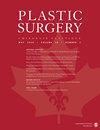Postoperative Complications of Direct-to-Implant and Two-Staged Breast Reconstruction: A Stratified Analysis
IF 0.7
4区 医学
Q4 SURGERY
引用次数: 0
Abstract
Background: Post-mastectomy implant-based reconstruction can be performed as direct-to-implant (DTI) or two-staged reconstruction (TSR). Rigorous studies have explored postoperative complications between TSR or DTI, yet few have stratified outcomes by relevant populations, pre-operative findings, mastectomy characteristics, or plane of implant placement. We sought to compare the outcomes between these cohorts at our institution. Methods: All patients who underwent skin- or nipple-sparing mastectomy followed by DTI or TSR from 2011 to 2021 at a large academic medical center were included. Data included demographics, ADM use, mastectomy weight, plane of implant placement, and postoperative complications. Results: 295 patients were included. 271 (91.9%) received TSR, and 24 (8.1%) underwent DTI. Compared to TSR, DTI had a higher rate of NAC necrosis ( P = .007) and dehiscence ( P = .016). There was no difference in rate of other complications. Regardless of procedure, higher BMI ( P = .002), higher grade ptosis ( P = .01), and larger mastectomy weights ( P = .022) were associated with increased risk of complication. Pre-pectoral placement was not associated with risk of NAC or mastectomy skin necrosis. Prior tobacco use was associated with higher risk of infection ( P = .036) and dehiscence ( P = .025). Neoadjuvant and adjuvant chemotherapy was associated with increased risk of capsular contracture( P = .009). Conclusions: Our study suggests that TSR may be preferred to minimize risk of NAC necrosis and wound dehiscence, especially in high-risk patients. Pre-pectoral placement did not significantly affect risk of mastectomy or NAC necrosis and should be considered in all cases to minimize morbidity. Higher risk conditions for alloplastic reconstruction include higher degrees of ptosis, history of tobacco use, and higher BMIs.直接植入和两阶段乳房重建术的术后并发症:分层分析
背景:乳房切除术后以植入物为基础的重建可以直接植入(DTI)或两阶段重建(TSR)的方式进行。已有严格的研究探讨了 TSR 或 DTI 的术后并发症,但很少有研究根据相关人群、术前检查结果、乳房切除特征或植入物放置平面对结果进行分层。我们试图比较本机构这些组群之间的结果。方法:纳入2011年至2021年期间在一家大型学术医疗中心接受皮肤或乳头保留乳房切除术,然后进行DTI或TSR的所有患者。数据包括人口统计学、ADM使用情况、乳房切除体重、植入物放置平面和术后并发症。结果:共纳入 295 名患者。271人(91.9%)接受了TSR,24人(8.1%)接受了DTI。与 TSR 相比,DTI 的 NAC 坏死率(P = .007)和开裂率(P = .016)更高。其他并发症的发生率没有差异。无论采用哪种手术,体重指数越高 ( P = .002)、上睑下垂程度越高 ( P = .01)、乳房切除重量越大 ( P = .022),并发症风险越高。胸大肌前置入与NAC或乳房切除皮肤坏死的风险无关。之前吸烟与感染(P = 0.036)和开裂(P = 0.025)风险较高有关。新辅助化疗和辅助化疗与囊膜挛缩风险增加有关 ( P = .009)。结论:我们的研究表明,TSR可能是将NAC坏死和伤口开裂风险降至最低的首选,尤其是在高风险患者中。胸大肌前放置对乳房切除或NAC坏死的风险没有明显影响,所有病例都应考虑使用,以最大限度地降低发病率。上睑下垂程度较高、有吸烟史和体重指数(BMI)较高的患者接受异体重建的风险较高。
本文章由计算机程序翻译,如有差异,请以英文原文为准。
求助全文
约1分钟内获得全文
求助全文
来源期刊

Plastic surgery
Medicine-Surgery
CiteScore
1.70
自引率
0.00%
发文量
73
期刊介绍:
Plastic Surgery (Chirurgie Plastique) is the official journal of the Canadian Society of Plastic Surgeons, the Canadian Society for Aesthetic Plastic Surgery, Group for the Advancement of Microsurgery, and the Canadian Society for Surgery of the Hand. It serves as a major venue for Canadian research, society guidelines, and continuing medical education.
 求助内容:
求助内容: 应助结果提醒方式:
应助结果提醒方式:


